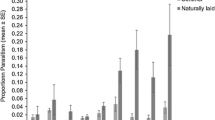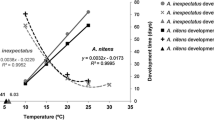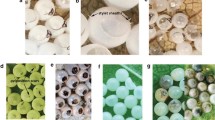Abstract
Passionvine hopper, Scolypopa australis (Walker) (Hemiptera: Ricaniidae), (PVH) is an introduced pest of kiwifruit grown in New Zealand. Two aphelinid egg parasitoids, Centrodora scolypopae Valentine and Ablerus sp., are thought to be its most important natural enemies. Rates of egg parasitism measured during 2010–2015 in the Bay of Plenty region and in a wider survey of the North Island of New Zealand in 2015 were ≤ 10% compared with medians of about 30–50% for historical estimates. PVH eggs laid in bracken, a favored host plant, in 2015 and 2019 were parasitized at about half the rate or less than indicated by measurements made 20, 35–38 and 57 years ago. The apparent decline may have been the result of asynchrony between one or both egg parasitoids and PVH associated with warmer summer and autumn temperatures. Further work is needed to clarify the role of each parasitoid in PVH population dynamics.






Similar content being viewed by others
References
Chambers JM, Hastie TJ (1992) Statistical models in S. Wadsworth and Brooks/Cole, Pacific Grove
Charles JG, Allan DJ (2004) Passionvine hopper, Scolypopa australis (Walker) (Hemiptera: Ricaniidae), egg parasitism by Aphelinidae (Hymenoptera) in New Zealand. N Z Entomol 27:83–89
Cumber RA (1966) Factors influencing population levels of Scolypopa australis Walker (Hemiptera-Homoptera: Ricaniidae) in New Zealand. N Z J Sci 9:336–356
Cumber RA (1967) Factors influencing egg survival of Scolypopa australis Walker (Hemiptera-Homoptera: Ricaniidae) in the Sydney area (N.S.W. Australia). N Z J Sci 10:639–643
Day WH (1994) Estimating mortality caused by parasites and diseases of insects: comparisons of the dissection and rearing methods. Environ Entomol 23:543–550
Fatouros NE, Dicke M, Mumm R, Meiners T, Hilker M (2008) Foraging behavior of egg parasitoids exploiting chemical information. Behav Ecol 19:677–689
Fletcher MJ (1979) Egg types and oviposition behaviour in some fulgoroid leafhoppers (Homoptera, Fulgoroidea). Aust Entomol Mag 6:13–18
Freeland WJ, Delvinqueir BLJ, Bonnin B (1986) Food and parasitism of the cane toad, Bufo marinus, in relation to time since colonization. Aust Wildl Res 13:489–499
Gaskin RE, Logan DP, May W, Rowe C, Steele KD, van Leeuwen R, Connolly PG (2012) Control of passionvine hopper and cicada eggs on dormant canes of kiwifruit with bifenthrin sprays containing a new super-penetrating adjuvant. N Z Plant Prot 65:100–105
Gerard PJ (1985) The ecology of Scolypopa australis and its parasite Centrodora scolypopae. Unpublished PhD thesis, University of Waikato, Hamilton
Gerard PJ (1989) Influence of egg depth in host plants on parasitism of Scolypopa australis (Homoptera: Ricaniidae) by Centrodora scolypopae (Hymenoptera: Aphelinidae). N Z Entomol 12:30–34
Gerard PJ (2004) Synchronisation of the parasitoid Centrodora scolypopae with its host Scolypopa australis. N Z Plant Prot 57:191–195
Harcourt SJ (1995) Screening of insecticides for use against passion-vine hopper, Scolypopa australis Walker (Homoptera: Ricaniidae): a basis for integrated pest management in kiwifruit. Unpublished M.Sc. thesis, University of Auckland, Auckland
Logan DP, Allison PA, Stannard K (2002) Selection of wild hosts for feeding by passion vine hopper, Scolypopa australis (Walker) (Hemiptera: Ricaniidae) in the Bay of Plenty. N Z Plant Prot 55:368–373
Marshall RK, Lester MT, Glare TR, Christeller JT (2003) The fungus, Lecanicillium muscarium, is an entomopathogen of passionvine hopper (Scolypopa australis). N Z J Crop Hort Sci 31:1–7
Martin NA (2018) Passion vine hopper - Scolypopa australis. Interesting insects and other invertebrates. New Zealand arthropod factsheet series number 111. https://nzacfactsheets.landcareresearch.co.nz/Index.html. Accessed 7 Oct 2019
Noyes JS (2019) Universal Chalcidoidea database. World Wide Web electronic publication. https://www.nhm.ac.uk/chalcidoids. Accessed 9 Oct 2019
Phillips BL, Shine R (2005) The morphology, and hence impact, of an invasive species (the cane toad, Bufo marinus): changes with time since colonisation. Anim Conserv 8:407–413
Polaszek A (1991) Egg parasitism in Aphelinidae (Hymenoptera: Chalcidoidea) with special reference to Centrodora and Encarsia species. Bull Ent Res 81:97–106
R Core Team (2019) R: a language and environment for statistical computing. R Foundation for Statistical Computing, Vienna, Austria. https://www.r-project.org/
Sarkar D (2008) Lattice: multivariate data visualization with R. Springer, New York
Simberloff D, Gibbons L (2004) Now you see them, now you don’t!: population crashes of established introduced species. Biol Invasions 6:161–172
Snyder R (1985) Hand calculating degree days. Agric For Meteorol 35(1–4):353–358
Steven D (1990) Entomology and kiwifruit. In: Warrington I, Weston GC (eds) Kiwifruit science and management. Ray Richards Publisher in association with the NZ Society for Horticultural Science, Auckland, pp 362–412
Strayer DL, D’Antonio CM, Essl F, Fowler MS, Geist J, Hilt S, Jarić I, Jöhnk K, Jones CG, Lambin X, Latzka AW, Pergl J, Pysek P, Robertson P, von Schmalensee M, Stefansson RA, Wright J, Jeschke JM (2017) Boom-bust dynamics in biological invasions: towards an improved application of the concept. Ecol Lett 20:1337–1350
Tomasetto F, Tylianakis JM, Reale M, Wratten SD, Goldson SL (2017) Intensified agriculture favors evolved resistance to biological control. Proc Natl Acad Sci USA 114:3885–3890
Tomasetto F, Cianciullo S, Reale M, Attorre F, Olaniyan O, Goldson SL (2018) Breakdown in classical biological control of Argentine stem weevil: a matter of time. BioControl 63:521–531
Valentine EW (1966) A new species of Centrodora (Hymenoptera: Aphelinidae) parasitic upon eggs of Scolypopa australis Walker (Hemiptera: Ricaniidae). N Z J Sci 9:331–335
Acknowledgements
This study was funded under the Strategic Science Investment Fund of Plant and Food Research during the years 2010–2019. Thanks to John Charles for access to unpublished notes and data, and to Pip Gerard for advice. Thanks also to the Plant and Food Research science publishing office, to Mark Wohlers for statistical advice, and colleagues Jessica Dohmen-Vereijssen and Anuar Morales-Rodriguez, and for journal reviewers for improvements to the draft manuscript.
Author information
Authors and Affiliations
Corresponding author
Ethics declarations
Conflict of interest
We declare that we have no conflicts of interest related to funding or otherwise.
Human and/or animal participants
No humans and/or animals were used in this study and no informed consent was necessary.
Additional information
Handling Editor: Stefano Colazza
Rights and permissions
About this article
Cite this article
Logan, D.P., Rowe, C.A. & Connolly, P.G. Long-term decline in the parasitism rate of passionvine hopper eggs (Scolypopa australis). BioControl 65, 547–558 (2020). https://doi.org/10.1007/s10526-020-10027-w
Received:
Accepted:
Published:
Issue Date:
DOI: https://doi.org/10.1007/s10526-020-10027-w




